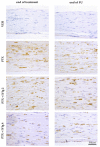Human Intravenous Immunoglobulin Alleviates Neuropathic Symptoms in a Rat Model of Paclitaxel-Induced Peripheral Neurotoxicity
- PMID: 33494384
- PMCID: PMC7865319
- DOI: 10.3390/ijms22031058
Human Intravenous Immunoglobulin Alleviates Neuropathic Symptoms in a Rat Model of Paclitaxel-Induced Peripheral Neurotoxicity
Abstract
The onset of chemotherapy-induced peripheral neurotoxicity (CIPN) is a leading cause of the dose reduction or discontinuation of cancer treatment due to sensory symptoms. Paclitaxel (PTX) can cause painful peripheral neuropathy, with a negative impact on cancer survivors' quality of life. While recent studies have shown that neuroinflammation is involved in PTX-induced peripheral neurotoxicity (PIPN), the pathophysiology of this disabling side effect remains largely unclear and no effective therapies are available. Therefore, here we investigated the effects of human intravenous immunoglobulin (IVIg) on a PIPN rat model. PTX-treated rats showed mechanical allodynia and neurophysiological alterations consistent with a severe sensory axonal polyneuropathy. In addition, morphological evaluation showed a reduction of intra-epidermal nerve fiber (IENF) density and evidenced axonopathy with macrophage infiltration, which was more prominent in the distal segment of caudal nerves. Three weeks after the last PTX injection, mechanical allodynia was still present in PTX-treated rats, while the full recovery in the group of animals co-treated with IVIg was observed. At the pathological level, this behavioral result was paralleled by prevention of the reduction in IENF density induced by PTX in IVIg co-treated rats. These results suggest that the immunomodulating effect of IVIg co-treatment can alleviate PIPN neurotoxic manifestations, probably through a partial reduction of neuroinflammation.
Keywords: IENF; axon degeneration; chemotherapy; intravenous immunoglobulin (IVIg); neuropathic pain; paclitaxel.
Conflict of interest statement
C.S and C.G are employees of Kedrion S.p.A. The other authors declare no conflict of interest. The funders had no role in the design of the study; in the collection, analyses, or interpretation of data; in the writing of the manuscript, or in the decision to publish the results.
Figures






Similar articles
-
High-dose intravenous immunoglobulins reduce nerve macrophage infiltration and the severity of bortezomib-induced peripheral neurotoxicity in rats.J Neuroinflammation. 2018 Aug 21;15(1):232. doi: 10.1186/s12974-018-1270-x. J Neuroinflammation. 2018. PMID: 30131066 Free PMC article.
-
Neurofilament light chain: a specific serum biomarker of axonal damage severity in rat models of Chemotherapy-Induced Peripheral Neurotoxicity.Arch Toxicol. 2020 Jul;94(7):2517-2522. doi: 10.1007/s00204-020-02755-w. Epub 2020 Apr 24. Arch Toxicol. 2020. PMID: 32333051
-
Macrophage Infiltration Initiates RIP3/MLKL-Dependent Necroptosis in Paclitaxel-Induced Neuropathic Pain.Mediators Inflamm. 2022 Sep 16;2022:1567210. doi: 10.1155/2022/1567210. eCollection 2022. Mediators Inflamm. 2022. PMID: 36164389 Free PMC article.
-
Platinum-induced peripheral neurotoxicity: From pathogenesis to treatment.J Peripher Nerv Syst. 2019 Oct;24 Suppl 2(Suppl 2):S26-S39. doi: 10.1111/jns.12335. J Peripher Nerv Syst. 2019. PMID: 31647151 Free PMC article. Review.
-
Pathogenesis of paclitaxel-induced peripheral neuropathy: A current review of in vitro and in vivo findings using rodent and human model systems.Exp Neurol. 2020 Feb;324:113121. doi: 10.1016/j.expneurol.2019.113121. Epub 2019 Nov 21. Exp Neurol. 2020. PMID: 31758983 Free PMC article. Review.
Cited by
-
Neuroprotective Effect of Polyvalent Immunoglobulins on Mouse Models of Chemotherapy-Induced Peripheral Neuropathy.Pharmaceutics. 2024 Jan 20;16(1):139. doi: 10.3390/pharmaceutics16010139. Pharmaceutics. 2024. PMID: 38276509 Free PMC article.
-
A mechanistic understanding of the relationship between skin innervation and chemotherapy-induced neuropathic pain.Front Pain Res (Lausanne). 2022 Dec 13;3:1066069. doi: 10.3389/fpain.2022.1066069. eCollection 2022. Front Pain Res (Lausanne). 2022. PMID: 36582196 Free PMC article. Review.
-
Neurological adverse events associated with PD-1/PD-L1 immune checkpoint inhibitors.Front Neurosci. 2023 Jun 29;17:1227049. doi: 10.3389/fnins.2023.1227049. eCollection 2023. Front Neurosci. 2023. PMID: 37456998 Free PMC article. Review.
-
Preclinical research in paclitaxel-induced neuropathic pain: a systematic review.Front Vet Sci. 2023 Dec 18;10:1264668. doi: 10.3389/fvets.2023.1264668. eCollection 2023. Front Vet Sci. 2023. PMID: 38188718 Free PMC article.
-
Paclitaxel, but Not Cisplatin, Affects Satellite Glial Cells in Dorsal Root Ganglia of Rats with Chemotherapy-Induced Peripheral Neurotoxicity.Toxics. 2023 Jan 19;11(2):93. doi: 10.3390/toxics11020093. Toxics. 2023. PMID: 36850969 Free PMC article.
References
-
- Oneda E., Meriggi F., Zanotti L., Zaina E., Bighè S., Andreis F., Rueda S., Zaniboni A. Innovative Approach for the Prevention of Chemotherapy-Induced Peripheral Neuropathy in Cancer Patients: A Pilot Study With the Hilotherm Device, the Poliambulanza Hospital Experience. Integr. Cancer Ther. 2020;19:1534735420943287. doi: 10.1177/1534735420943287. - DOI - PMC - PubMed
-
- Reeves B.N., Dakhil S.R., Sloan J.A., Wolf S.L., Burger K.N., Kamal A.H., Le-Lindqwister N.A., Soori G.S., Jaslowski A.J., Kelaghan J., et al. Further data supporting that paclitaxel-associated acute pain syndrome is associated with development of peripheral neuropathy. Cancer. 2012;118:5171–5178. doi: 10.1002/cncr.27489. - DOI - PMC - PubMed
-
- Fehrenbacher J.C. Chemotherapy-Induced Peripheral Neuropathy. Prog. Mol. Biol. Transl. Sci. 2015;131:471–508. - PubMed
MeSH terms
Substances
Grants and funding
LinkOut - more resources
Full Text Sources
Other Literature Sources
Medical

